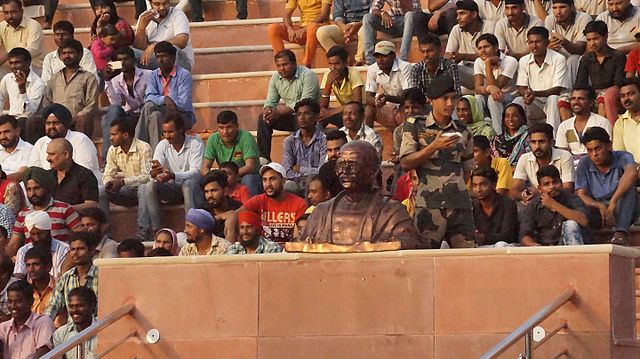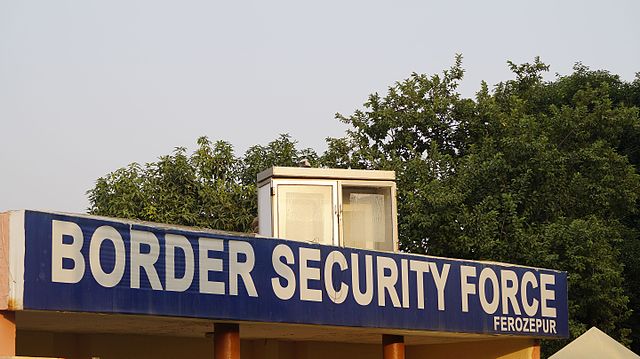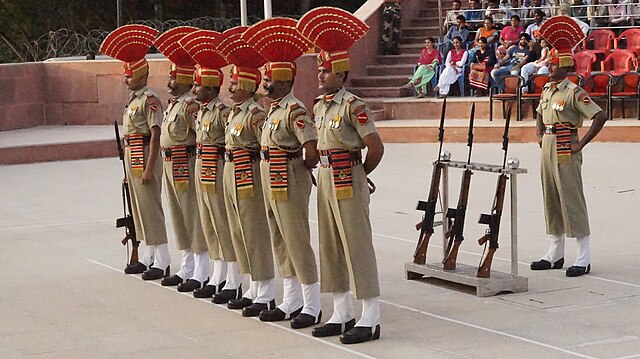Have you ever wondered about the stories that border crossings tell? Hussainiwala Border isn’t just another line on a map – it’s a living testament to history, sacrifice, and the enduring human spirit. This remarkable border crossing between India and Pakistan carries within its grounds the echoes of partition, the memory of martyrs, and the hopes of millions who’ve crossed its threshold.
What is Hussainiwala Border?
Hussainiwala Border stands as one of the most significant border crossings between India and Pakistan, located in the Firozpur district of Punjab, India. Unlike many other border points that serve purely administrative purposes, this crossing holds deep emotional and historical significance for both nations.
The border serves multiple functions – it’s a checkpoint for international travelers, a memorial site honoring freedom fighters, and a symbol of the complex relationship between two neighboring countries. What makes Hussainiwala truly special is its dual identity as both a functional border crossing and a place of pilgrimage for those who wish to pay their respects to India’s revolutionary heroes.
Location and Geographic Significance
Strategically positioned along the Sutlej River, Hussainiwala Border sits approximately 10 kilometers from Firozpur city. The location wasn’t chosen randomly – it represents a natural geographical boundary that has served as a crossing point for centuries, long before the modern borders were drawn.
The border’s position along the river creates a unique landscape where the flowing waters of the Sutlej seem to whisper stories of the past. The geographic significance extends beyond mere location – it represents the agricultural heartland of Punjab, where the fertile plains have witnessed both prosperity and partition’s pain.
Border Infrastructure and Facilities
Modern Hussainiwala Border boasts well-developed infrastructure designed to handle both regular cross-border traffic and the thousands of pilgrims who visit annually. The facility includes immigration offices, customs checkpoints, waiting areas, and security installations that ensure smooth operations while maintaining strict border protocols.
The infrastructure reflects the border’s dual purpose – serving as both a functional crossing and a memorial site. Visitor facilities include parking areas, information centers, and amenities that cater to the needs of tourists and pilgrims who come to pay their respects at the nearby memorial.
Historical Background of Hussainiwala Border

Understanding Hussainiwala Border requires diving deep into the tumultuous history of the Indian subcontinent. This border crossing didn’t emerge overnight – it’s the product of historical events that shaped the destiny of millions.
Partition Era and Early Establishment
The partition of India in 1947 created new international boundaries, and Hussainiwala found itself at the center of this historic transformation. What was once a small village became a significant border point overnight, as families were separated and new nations were born.
During the partition, this area witnessed the massive movement of populations – Hindus and Sikhs moving towards India, while Muslims migrated to the newly formed Pakistan. The border became a silent witness to both the tragedy of displacement and the hope of new beginnings. The establishment of formal border controls here symbolized the new reality of a divided subcontinent.
Evolution Over the Decades
From its humble beginnings as a temporary crossing point, Hussainiwala Border has evolved into a modern, well-equipped facility. The 1960s saw significant infrastructure development, while the 1970s brought enhanced security measures following various conflicts between the two nations.
The transformation continued through the decades, with the border adapting to changing political climates, security requirements, and the growing importance of the memorial site. Each decade brought new challenges and opportunities, shaping the border into what it is today – a complex blend of security installation, historical monument, and cultural symbol.
Shaheed Bhagat Singh Memorial at Hussainiwala
Perhaps no single element defines Hussainiwala Border’s significance more than the memorial dedicated to Shaheed Bhagat Singh and his fellow revolutionaries. This isn’t just a monument – it’s a sacred site where history comes alive.
The Martyrdom Site
On March 23, 1931, three young revolutionaries – Bhagat Singh, Rajguru, and Sukhdev – were executed by the British colonial government. Their bodies were secretly cremated at Hussainiwala to prevent public demonstrations. What the British intended as a secretive end to revolutionary activities instead became the birthplace of a legend.
The site where these heroes were cremated has been transformed into a memorial that attracts hundreds of thousands of visitors annually. The location carries immense emotional weight – it’s where the ashes of martyrs merged with the soil of Punjab, creating hallowed ground that continues to inspire generations.
Memorial Complex and Museum
The memorial complex at Hussainiwala is a masterpiece of architectural planning and emotional storytelling. The main memorial structure stands tall, surrounded by beautifully landscaped gardens that provide a peaceful environment for reflection and remembrance.
The complex includes a museum that houses artifacts, photographs, and documents related to the freedom struggle. Interactive displays bring history to life, allowing visitors to understand the context of the martyrs’ sacrifice and the broader independence movement. The museum serves as an educational hub, ensuring that the stories of these heroes continue to inspire future generations.
Visitor Experience and Exhibits
Walking through the memorial complex is like stepping back in time. The exhibits are carefully curated to provide a comprehensive understanding of the revolutionaries’ lives, their ideology, and their ultimate sacrifice. Personal belongings, letters, and photographs create an intimate connection between visitors and the heroes they’re honoring.
The visitor experience is designed to be both educational and emotional. Audio-visual presentations, guided tours, and interactive displays ensure that every visitor leaves with a deeper understanding of the price of freedom and the courage of those who paid it.
Border Crossing Procedures and Requirements
For those planning to cross the border at Hussainiwala, understanding the procedures and requirements is crucial. The process, while straightforward, requires proper documentation and adherence to specific protocols.
Documentation Needed
Crossing the Hussainiwala Border requires valid travel documents – primarily a passport with appropriate visas. Indian citizens need a valid passport and Pakistani visa, while Pakistani citizens require a passport and Indian visa. The documentation requirements are strict, and incomplete paperwork can result in denial of entry.
Additional documents may be required depending on the purpose of travel. Business travelers might need commercial licenses, while those visiting for religious purposes may need special permits. It’s essential to check current requirements before traveling, as regulations can change based on political climate and security considerations.
Crossing Process Step-by-Step
The border crossing process at Hussainiwala follows a systematic approach designed to ensure security while facilitating legitimate travel. The process begins with document verification on the departure side, followed by customs clearance and immigration formalities.
Once cleared by the departure country’s authorities, travelers proceed to the arrival side, where they undergo similar processes – document verification, customs inspection, and immigration clearance. The entire process typically takes 2-4 hours, depending on the volume of travelers and the thoroughness of security checks.
Timings and Operational Hours
Hussainiwala Border operates on specific schedules that travelers must adhere to. The border typically opens at 9:00 AM and closes by 4:00 PM, though these timings can vary based on security situations and bilateral agreements between the two countries.
It’s important to arrive well before closing time, as the border crossing process can be time-consuming. The border remains closed on certain national holidays and during periods of heightened tension, so checking current operational status before travel is essential.
Cultural and Economic Impact
Hussainiwala Border serves as more than just a crossing point – it’s a bridge between cultures and economies, facilitating exchange that benefits both sides of the border.
Cross-Border Trade Activities
Despite political tensions, Hussainiwala facilitates legitimate trade between India and Pakistan. Agricultural products, textiles, and handicrafts flow through this crossing, contributing to the economic well-being of border communities.
The trade activities at Hussainiwala represent the practical benefits of peaceful coexistence. When relations between the two countries improve, trade volumes increase, demonstrating the economic potential of normalized relations. Local communities on both sides benefit from this trade, creating stakeholders in peaceful border management.
Cultural Exchange Programs
Hussainiwala has occasionally hosted cultural exchange programs that bring together people from both sides of the border. These programs, though limited by political constraints, showcase the shared cultural heritage that transcends political boundaries.
Music, dance, literature, and art find common ground at these exchanges, reminding participants of their shared history and cultural roots. Such programs demonstrate the power of cultural diplomacy in building bridges between nations and communities.
Tourism at Hussainiwala Border

Tourism at Hussainiwala Border offers a unique blend of historical significance, cultural importance, and border experience that attracts visitors from across India and abroad.
Popular Attractions Nearby
Beyond the memorial itself, the Hussainiwala area offers several attractions that enhance the visitor experience. Historical sites, religious places, and cultural centers provide a comprehensive understanding of the region’s rich heritage.
The nearby Harike Wetland, one of the largest wetlands in northern India, offers excellent bird watching opportunities and natural beauty. The combination of historical significance and natural attractions makes Hussainiwala a compelling destination for diverse types of travelers.
Best Time to Visit
The best time to visit Hussainiwala Border is during the cooler months from October to March, when the weather is pleasant and comfortable for outdoor activities. The memorial and border area can be quite hot during summer months, making sightseeing challenging.
The anniversary of the martyrs’ sacrifice (March 23) sees particularly high visitor numbers, as people from across the country come to pay their respects. This period offers a unique opportunity to witness the deep emotional connection people have with the site, though visitors should expect larger crowds.
Accommodation Options
Firozpur, the nearest major town, offers various accommodation options ranging from budget hotels to mid-range establishments. The proximity to the border makes it convenient for visitors who want to explore the memorial complex thoroughly.
For those seeking more comfortable accommodations, larger cities like Ludhiana and Amritsar are within driving distance and offer luxury hotels and better amenities. The choice of accommodation depends on individual preferences and the duration of stay.
Security Measures and Border Management
Security at Hussainiwala Border is managed with utmost seriousness, reflecting the sensitive nature of the India-Pakistan border and the importance of maintaining peace and stability.
BSF Operations
The Border Security Force (BSF) is responsible for managing the Indian side of Hussainiwala Border. Their operations include regular patrolling, surveillance, and ensuring the security of both the border crossing and the memorial site.
BSF personnel undergo specialized training to handle the unique challenges of border management while maintaining the dignity and respect appropriate for a memorial site. Their presence ensures that visitors can pay their respects in a secure environment while maintaining the border’s integrity.
Modern Security Technologies
Hussainiwala Border employs modern security technologies including surveillance cameras, motion sensors, and communication systems that enhance border security. These technologies help in monitoring the border area continuously while ensuring that legitimate activities can proceed smoothly.
The integration of technology with human intelligence creates a comprehensive security framework that protects both the border and the visitors who come to honor the martyrs’ memory.
Transportation and Accessibility
Reaching Hussainiwala Border requires planning, but the journey is well worth the effort for those interested in history, culture, and cross-border experiences.
How to Reach Hussainiwala Border
Hussainiwala Border is accessible by road from major cities in Punjab and neighboring states. The nearest railway station is Firozpur, which is connected to major cities across India. From Firozpur, local transportation options are available to reach the border.
For those traveling by air, the nearest airport is in Amritsar, approximately 120 kilometers away. From the airport, taxi services and buses provide connectivity to Hussainiwala via Firozpur. The journey offers scenic views of Punjab’s agricultural landscape.
Local Transportation Options
Local transportation around Hussainiwala includes auto-rickshaws, taxis, and buses that connect the border to nearby towns and cities. Private vehicle rental is also available for those who prefer independent travel.
The local transportation system is well-developed to handle the influx of visitors to the memorial site. During peak visiting seasons, additional transportation services are often arranged to accommodate the increased number of pilgrims and tourists.
Current Challenges and Future Prospects
Like many border crossings between India and Pakistan, Hussainiwala faces various challenges while holding promise for future development and enhanced cooperation.
Infrastructure Development Plans
Plans for infrastructure development at Hussainiwala include improvements to visitor facilities, enhanced security installations, and better connectivity to major cities. These developments aim to accommodate increasing visitor numbers while maintaining security standards.
Future plans also include the development of interpretation centers and educational facilities that will enhance the memorial’s role as a center for learning about India’s freedom struggle and the sacrifice of its heroes.
The development of Hussainiwala Border represents hope for improved relations between India and Pakistan, demonstrating that shared history and cultural connections can provide a foundation for peaceful coexistence and mutual prosperity.
Conclusion
Hussainiwala Border stands as a powerful symbol of history, sacrifice, and the enduring human spirit. From its role as a witness to partition’s trauma to its current status as a memorial honoring revolutionary heroes, this border crossing embodies the complex relationship between India and Pakistan.
The memorial to Shaheed Bhagat Singh and his fellow martyrs ensures that their sacrifice continues to inspire future generations, while the border itself serves as a reminder of both division and the potential for unity. Whether you’re a history enthusiast, a pilgrim seeking to honor martyrs, or simply someone interested in understanding the complexities of the subcontinent, Hussainiwala Border offers a profound and moving experience.
As we look toward the future, Hussainiwala Border holds the promise of enhanced cooperation, increased cultural exchange, and continued remembrance of the heroes who gave their lives for freedom. It remains a testament to the idea that borders, while necessary, need not be barriers to understanding, respect, and peaceful coexistence.
Frequently Asked Questions (FAQs)
1. What are the visiting hours for the Shaheed Bhagat Singh Memorial at Hussainiwala Border?
The memorial is typically open from 9:00 AM to 5:00 PM daily, though hours may vary during special occasions or security situations. It’s advisable to check current timings before visiting, especially during national holidays or memorial anniversary dates.
2. Can tourists visit Hussainiwala Border without crossing into Pakistan?
Yes, tourists can visit the memorial site and border area without crossing into Pakistan. The memorial complex is located on the Indian side and is accessible to all visitors with proper identification. However, crossing the border requires valid travel documents and visas.
3. What is the best way to reach Hussainiwala Border from major cities like Delhi or Mumbai?
The most convenient route is to travel to Firozpur by train or bus from major cities, then take local transportation to the border. Alternatively, you can fly to Amritsar and drive to Hussainiwala via Firozpur. The journey from Delhi takes approximately 6-7 hours by road.
4. Are there any restrictions on photography at Hussainiwala Border?
Photography is generally allowed at the memorial site, but restrictions may apply near the actual border crossing and security installations. It’s best to ask permission from security personnel before taking photographs, especially in sensitive areas.
5. What should visitors expect when attending the annual memorial ceremony on March 23?
The annual ceremony on March 23 (anniversary of the martyrs’ sacrifice) attracts large crowds and features special programs including speeches, cultural performances, and wreath-laying ceremonies. Visitors should expect larger crowds, enhanced security measures, and a deeply emotional atmosphere as people from across the country gather to honor the martyrs.

